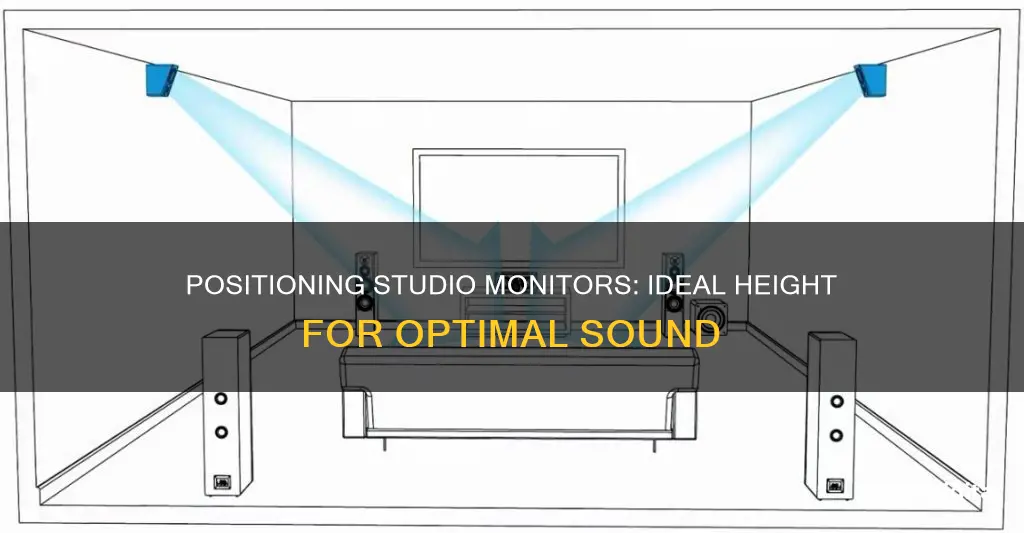
Studio monitor placement is crucial to achieving an accurate listening experience. The ideal height for a studio monitor is for the tweeters to be at ear level when seated, which is typically about 47-55 inches (120-140 cm) from the floor. However, the height may vary depending on factors such as the size of the room, the type of monitors, and the listening position. Placing the monitors at ear level helps to create a consistent and accurate sound stage, allowing for a more precise mixing and recording experience.
| Characteristics | Values |
|---|---|
| Speaker height | Ideally, the tweeters should be at the same height as your ears when seated, typically about 47-55 inches (120-140 cm) from the floor. |
| Speaker placement | Speakers should be placed slightly above or below the mid-way point between the floor and ceiling. |
| Speaker angle | Speakers should be angled towards the listening position at an angle of around 30 degrees to align with the ears of the listener. |
| Speaker distance | Speakers should be placed at a minimum distance of 20-30 cm (8-12 inches) from the walls and a maximum distance of 60-90 cm. |
What You'll Learn

The tweeter should be at ear level
When setting up your studio monitors, it's important to get the height just right to ensure the best sound experience. So, how high should your studio monitors be? Well, the general consensus is that you should aim for ear level.
Positioning the tweeters of your studio monitors at ear level is crucial for achieving the optimal sound experience. This means that the tweeters should be at the same height as your ears when you are seated in front of them. The standard height range for this is 47-55 inches (120-140 cm) from the floor. However, the exact height may vary slightly depending on your setup and personal preferences. For example, if you need to clear the top of your computer monitor, you can place the speakers slightly higher and tilt them downwards.
The reason ear level is the ideal height for studio monitors is that it ensures you are hearing the sound directly from the speakers, without excessive reflections from nearby surfaces. By minimising these reflections, you get a more accurate and balanced sound. Additionally, having the tweeters at ear level allows you to better discern what is happening at the higher end of the frequency spectrum, enhancing your overall listening experience.
To achieve the perfect height for your studio monitors, you may need to invest in some speaker stands or isolation pads. These accessories will allow you to adjust the height and angle of your monitors to ensure they are positioned correctly relative to your ears. It's worth noting that you should avoid placing your monitors directly on top of your console or desktop, as this can cause unwanted reflections and vibrations that can interfere with the sound.
In summary, getting your studio monitors to ear level is crucial for achieving the best sound quality. By positioning the tweeters at the optimal height, you ensure that you are hearing the full range of frequencies directly from the speakers, resulting in a more immersive and accurate listening experience.
How Adding a Monitor Affects Your Productivity and Performance
You may want to see also

Avoid placing monitors on hard surfaces
Studio monitors should not be placed directly on hard surfaces such as a console or desktop. This is to avoid unwanted reflections and vibrations.
Monitor stands are a good investment, as they allow you to separate the monitors from the rest of your setup and easily adjust their distance and orientation. If stands are not an option, you can use decouplers, which isolate monitors from the surface they are placed on, or isolation pads, which will help absorb vibrations and mitigate resonances. Pads, or rubber feet, can also be used with stands to help control vibrations.
The HEDD MK2 monitor range features desktop filters with three different tunings designed to compensate for acoustic issues that arise from placing the monitors flat on a hard surface.
In addition to stands, you can also use angling stands to raise your monitors and angle them towards you, which can provide a good middle ground.
Monitor Graphics Card Failing: How to Spot the Signs
You may want to see also

Monitors should be at a 30-degree angle
When setting up studio monitors, it is important to find the ideal listening position or "sweet spot". This will ensure that you hear everything in your mix correctly. The room you are working in will have a specific set of resonant frequencies that will create what are known as "modes", which are caused by sound reflecting off different surfaces. The effects of these room modes depend on the position of both the listener and the monitors.
One commonly recommended setup for studio monitors is to have them positioned at a 30-degree angle. This is achieved by placing the listening position and the monitors at the three points of an equilateral triangle, with the monitors turned towards the listener's ears. This setup helps to create a balanced stereo image and a more reliable frequency response.
The 30-degree angle is not a hard and fast rule, however. Some people choose to deviate from it, experimenting with different angles to find the setup that works best for them. The ideal angle may also depend on the specific monitors being used, as some speakers have different dispersion patterns. It is generally recommended to use your ears and adjust the angle accordingly to get the best sound.
In addition to angle placement, it is also important to consider the height of the monitors. Ideally, you want the tweeters of the speakers to be at head height (ear level) so that your ears are directly in front of the speakers. This will provide the most consistent and best sound. If your setup does not allow you to get the monitors high enough, you can use speaker stands to elevate them.
By finding the right angle and height for your studio monitors, you can achieve a more accurate listening experience and ensure that your mixes translate well to different playback systems.
Cutting Off Ankle Monitors: A Step-by-Step Guide
You may want to see also

Avoid placing monitors in corners
The ideal placement for studio monitors is in the front area of the room, centred relative to the wall they face and equidistant from the walls to their side and back. However, placing monitors in the corners of a room is not recommended.
Every solid surface in a room constitutes a potential boundary that sound waves will reflect off of, causing phase cancellations and other unwanted acoustic interactions. Placing studio monitors in corners will create issues in the lower end of the spectrum, especially if the monitors are rear-ported. This is because the port at the back of the woofer allows air to escape, and placing the monitors in corners will cause issues with these backfiring ports.
If you place your monitors in a corner, you will need to invest in sound treatment to compensate for the shortcomings of this placement. You can try placing bass traps in the corner behind the speakers, or use a shelving filter to roll off the lows. You can also use a plugin that does this in your master bus, but remember to disable it when bouncing.
In conclusion, while it is not ideal to place studio monitors in corners, it can be done with sufficient sound treatment.
Connecting a Surface Pro to a Monitor: Easy Steps
You may want to see also

Monitors should be at head height
When setting up a studio, it is important to get the monitor placement right to ensure an accurate listening experience. One of the key considerations is the height of the monitors. So, should monitors be at head height?
The short answer is yes. Positioning the tweeters of your speakers at head height, or ear level, is generally recommended. This ensures that your ears are directly in front of the speakers, allowing you to hear the sound more clearly and accurately. It is also important for creating a consistent listening experience, as the directional pattern of sound emanating from the speaker, known as horizontal and vertical dispersion, varies as you move from the front and centre of the speaker.
If your monitor stands or console are too low, you can use speaker stands or isolation stands to elevate them. The ideal height for the tweeters is typically about 47-55 inches (120-140 cm) from the floor. However, this may vary depending on the specific setup and can be adjusted to suit your needs. For example, if you need to clear the top of your computer monitor, you can place the speakers slightly higher and tilt them down towards you.
It is worth noting that there is some debate about whether to position the speakers with the tweeter or the woofer at ear level. Some people argue that having the tweeter at ear level helps to more accurately discern what is happening at the higher end of the frequency spectrum. Others prefer to have the woofer at ear level. Ultimately, it is a matter of personal preference, and you may need to experiment with both setups to determine which works best for you.
In addition to height, there are other important factors to consider when positioning your studio monitors, such as the distance from the walls and the angle at which the monitors are tilted. Overall, finding the right monitor placement will help you achieve a mixing environment that ensures the best results.
Troubleshooting an ASUS Monitor Flashing On and Off
You may want to see also
Frequently asked questions
Ideally, the tweeters of your studio monitors should be placed at ear level or head height when seated. This will allow you to accurately discern what is happening at the higher end of the frequency spectrum.
The ideal setup for correct stereo imaging is to have your listening position and monitor placements create three points of an equilateral triangle. The monitors should be turned in to aim towards your ears at approximately a 30-degree angle to the centre line.
It is recommended to place your studio monitors at least 43 inches (110 cm) away from the front wall to avoid an exaggerated bass response. Additionally, a minimum distance of 20-30 cm (8-12 inches) between the monitors and walls is generally enough to reduce sound waves reflecting back to your listening position.







